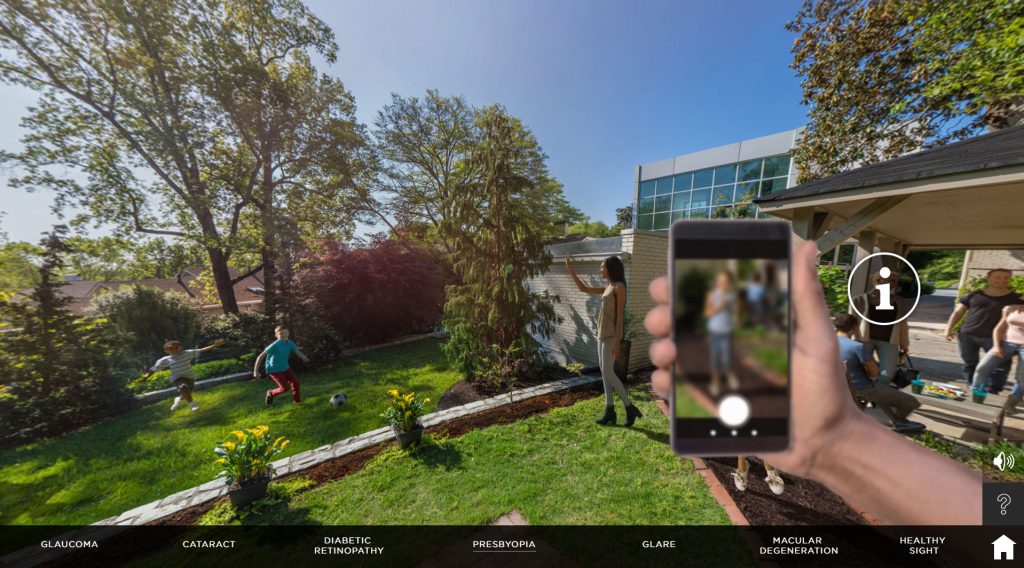Aging is a natural part of life and along with the rest of the body, it is common for eyes to go through changes as we age. One change that is a natural part of the aging process of the eye is presbyopia.
What is presbyopia?
Although being told you have presbyopia may sound scary, it is not a disease. Presbyopia is when your eyes gradually lose the ability to see things clearly up close. It usually appears around age 40, causing blurred vision when reading small print or using digital devices. It is as natural as developing wrinkles on your face as you get older, and it affects everyone at some point in life. Even if you’ve never had a vision problem before, or are nearsighted, everyone experiences some loss of focusing power for near objects as they age and some will notice this more than others.
Presbyopia is also often confused with farsightedness, but the two are different. Presbyopia occurs when the eye’s lens loses flexibility. Farsightedness occurs as a result of the shape of the eyeball, which causes light rays to bend incorrectly once they have entered the eye.
Nearly 1.7 billion people worldwide are affected by presbyopia, and that number is expected to grow to 2.1 billion by the year 2020. In the United States, more than 111 million adults are presbyopic and this number is estimated to grow to 123 million by 2020 due to aging of the population.
What are symptoms and signs of presbyopia?
Presbyopia develops gradually. Some signs of presbyopia include having a hard time reading small print, having to hold reading material (books, magazines, menus, digital devices, labels, etc.) farther than arm’s distance, and difficulty seeing objects that are close to you. Also, even if you can still see pretty well up close, presbyopia can cause headaches, eye strain and visual fatigue that makes reading and other near vision tasks less comfortable and more tiring.
What causes presbyopia?
Presbyopia is caused by an age-related process that results in the hardening of the lens of your eye. Your clear lens sits inside the eye behind your colored iris (the colored part of the eye). It changes length or shape to focus light onto the retina so you can see. When you look at something at a distance, the circular muscle around the lens relaxes. When you look at something nearby, the muscle constricts, allowing the relatively elastic lens to curve and change its focusing power. When you are young, the lens is soft and flexible, easily changing shape. The ability of the lens to change shape is called the elasticity of the lens. This elasticity is slowly lost as people age. Over time, changes occur within the proteins in the lens and it becomes more rigid, less elastic and cannot change shape as easily. As a result, close-up images appear out of focus.
What is it like to see through eyes of someone with presbyopia?
It is one thing to read that presbyopia causes blurred vision when reading small print or using digital devices, but to see through the eyes of someone effected by presbyopia gives an even better understanding. How would your daily activities be impacted? What moments would you lose? Whose faces would you miss? Experience the impact presbyopia has on sight by using the Vision Simulator at bcbsfepvision.com/visionsimulator.
How is presbyopia diagnosed?
Presbyopia can be found during a comprehensive optometric eye examination. If you notice any changes in your vision, you should visit an eye care professional. Exams are recommended more often after the age 40 to check for age-related conditions.
How do you treat presbyopia?
There is no cure for presbyopia and there is no way to stop or reverse the normal aging process that causes presbyopia. However, presbyopia can be corrected with eyeglasses, contact lenses or surgery.
Bifocals, progressive lenses and reading glasses are all options for correcting presbyopia with eyeglasses. Bifocals correct for close-up and far vision. A line divides the lens so that the bottom of the lens bends (refracts) light for close up vision, and the top portion refracts light to allow you to see distant objects. Progressive lenses correct vision like bifocals and are the most popular solution for presbyopia for most people over the age of 40. These line-free multifocal lenses restore clear, near vision and provide excellent vision at all distances, regardless of what refractive errors you may have in addition to presbyopia. Reading glasses help correct close-up vision problems by refracting light before it enters your eye. They can be bought without a prescription or, if you wear contact lenses, your eye doctor can prescribe reading glasses that you wear while your contacts are in. You can purchase readers over-the-counter at a retail store, or you can get higher-quality versions prescribed by your eye doctor.
Some people prefer to wear contact lenses rather than eyeglasses. There are two types of contact lenses that help presbyopia, monovision contacts and multifocal contacts. Monovision contacts correct one eye for distance vision and the other for close-up vision. You need to adapt to monovision lenses and train your brain to see this way. The downside to monovision contacts is that you may find you lose your ability to judge something’s distance or speed. Multifocal contacts have several rings or zones set at different powers that cause you to use both near and far vision at the same time, and your brain learns to automatically select the right focus for what you want to see. With a multifocal lens you may find that your vision is less sharp than when using a monofocal lens.
Don’t want to wear eyeglasses or contact lenses for presbyopia? A number of surgical options to treat presbyopia are available as well. Implantation of a corneal inlay, nearVision CK, monovision LASIK, presbyLASIK and refractive lens exchange are all surgical procedures that can be done. The first step to see if you are a good candidate for presbyopia surgery is to have a comprehensive eye exam and a consultation with a refractive surgeon who specializes in the surgical correction of presbyopia.
If you do not correct presbyopia, you may be bothered by headaches and eye strain. Regular visits to your eyecare professional can help find proper vision correction for presbyopia to help ensure you can take pictures of all the moments you want to remember.
Sight is precious; take care of your eyes with regular exams and proper eyewear.
Sources:
- All About Vision. Presbyopia.
- American Academy of Ophthalmology. What Is Presbyopia?
- American Optometric Association. Presbyopia.
- Cleveland Clinic.
- National Eye Institute. Facts about Presbyopia.


